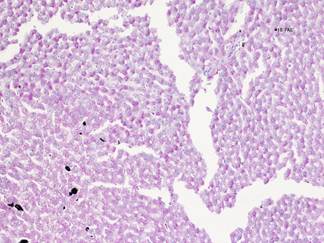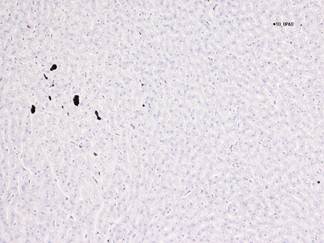
Special Stains - PAS & PAS D(Diastase)
- Periodic Acid schiff - Carbohydrate and Glycogen
- PAS D - Fungi
- PAS + PAS D Technique
This stain is used to stain carbohydrates in tissue sections. In this reaction periodic acid brings about oxidation of the 1-2 glycols carbon to carbon bond to form di-aldehydes. These di-aldehydes will then react with the fuschsin-sulphorous acid which will then combine with the basic pararosaniline or Schiff reagent to form a strong magenta colouration compound. This can then be used for diagnosis, for example fungal infections, but also for other cases like glycogen storage disorders as well.
A modification of that technique is a procedure called PAS D. This is carried out by the addition of amylase at the beginning of the procedure to digest glycogen that is present in the tissue. The diastase enzyme acts by cleaving the a-glucosidic 1-4 linkages of glycogen leading to the formation of maltose and dextrose which is soluble in water and is easily washed away and so does not interfere in the reaction.
The reason for the use of a digestion step would be to increase the specificity of the staining technique, for example analysis of glycogen deposits within the liver to detect how much glycogen is present, highlighting a thickened basement membrane for example in lupus or to make it easier for the detection of fungal infections. Also the removal of glycogen makes it easier to identify the neutral mucins which are also stained by the PAS technique, which is useful for diagnosis of adenocarcinoma.
1. Take sections to water.
2. Treat section with amylase for 15 minutes at room temperature (PAS D only)
3. Wash well in tap water for 5 minutes
4. Treat section with 1% periodic acid for 10 minutes
5. Wash well in water
6. Cover with Schiff's Reagent for 20 minutes at room temperature
7. Wash well in hot running water for 5 minutes
8. Stain nuclei with haematoxylin for 20 seconds
9. Wash in water 10. Differentiate Acid Alcohol 11. Wash in water, blue lithium carbonate 12. Wash, dehydrate, clear and mount Results Glycogen and other PAS reactive material - Magenta (Absent in PAS D) Nuclei - Blue The results can be seen below, the amylase removes the glycogen, leaving the section considerably paler in the PASD compared to the PAS. Photo – PAS x10 Photo – PAS-D x10 
